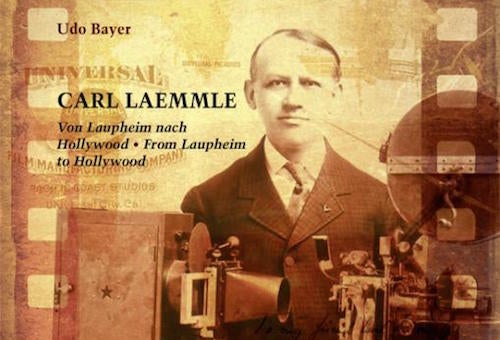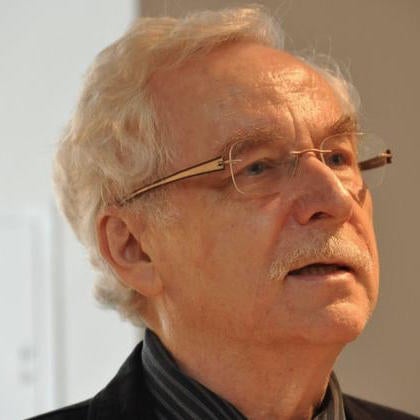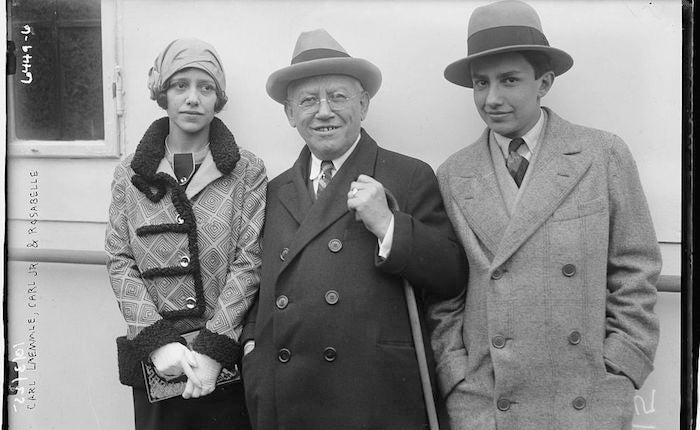
Over my career I have met many nonprofessional film historians, who passionately seek out arcane facts about their chosen object of study. Most are not academically trained in film historical discourses or theory, but they make up for it in their dogged persistence of a singular goal. Such a film historian was Dr. Udo Bayer, an internationally recognized specialist on Carl Laemmle, the founder of Universal. A few weeks ago, I received notification from his wife Gabi that Dr. Bayer had passed on September 25 after a long illness.
I first met Udo in person in 2003, when he visited Los Angeles to meet Carla Laemmle, who was Carl’s niece and appeared in Dracula (1931). Udo and I had been in correspondence since the late-1990s, when I was founding director of Universal Studios Archives & Collections, and he was already researching Laemmle for a book project. I was able to supply him with some important documents from the Universal collections and we then kept in touch while he followed other leads.
Dr. Bayer was born in 1944 in Hechingen, a small town in southern Germany, about 60 miles from Laupheim, which was the birthplace of Carl Laemmle. Udo was awarded a Ph.D. in semiotics, before becoming a high school educator in Laupheim. In 1988, he became friends with Ruth Regis, a grandniece of Carl Laemmle, when she visited Laupheim. From that moment on, Dr. Bayer started a campaign to have the local high school named after Laemmle and in memory of the relatively large Jewish community that had called Laupheim home before 1933. Named Assistant Director of the  school in 1989, Bayer was finally successful in having his school renamed the Carl-Laemmle-Gymnasium in 1994. Not only was Laemmle a native son, he had also supported many townspeople in Laupheim after WWI, when he made yearly pilgrimages to the small town south of Ulm -- at least until Hitler’s Storm Troopers shut down screenings of Laemmle’s production All Quiet on the Western Front in 1930 and let him know his presence would not be welcomed in the new Reich. More surprisingly, Laemmle signed affidavits for over 300 local Jewish citizens, allowing them to emigrate to America and escape the Holocaust.
school in 1989, Bayer was finally successful in having his school renamed the Carl-Laemmle-Gymnasium in 1994. Not only was Laemmle a native son, he had also supported many townspeople in Laupheim after WWI, when he made yearly pilgrimages to the small town south of Ulm -- at least until Hitler’s Storm Troopers shut down screenings of Laemmle’s production All Quiet on the Western Front in 1930 and let him know his presence would not be welcomed in the new Reich. More surprisingly, Laemmle signed affidavits for over 300 local Jewish citizens, allowing them to emigrate to America and escape the Holocaust.
That last fact remained obscure for decades until Udo Bayer published his magnum opus, Carl Laemmle und die Universal: Eine transatlantische Biographie, in German in 2013. In the book, Bayer described in detail Laemmle’s efforts, beginning in 1936, to rescue his Jewish friends and neighbors, even though he had left town more than 40 years earlier. The word on many of the Hollywood Jewish moguls was that they had done little to nothing to help European Jewry in distress, and even tried to find accommodations with the Nazis, so they could continue distributing films there after Hitler’s ascent to power. Not so with Carl Laemmle. He in fact made a pest of himself with the American State Department, which was covertly committed to keeping Jewish refugees out of the United States. The American consul in Stuttgart was said to have replied, “Tell me how many inhabitants Laupheim has,” when he was bombarded with requests for visas listing Laemmle as the sponsor.

Carl Laemmle with children Rosabelle and Carl Jr.
Among the rescued was Hermann Einstein, the cantor and Hebrew teacher in Laupheim, who arrived in Los Angeles in 1937 and became a Hebrew tutor for Carl Jr., the 30-year-old heir apparent. When Laemmle passed away in 1939, Einstein was still living in the Laemmle home and became one of the pallbearers. Einstein’s son, Sandy, published a memoir about his father and Laemmle, after contacting Udo Bayer and receiving numerous documents from him. Udo was in fact extremely generous with all the documents he had discovered after years of research. The story of Laemmle’s efforts broke in the American media last year when Neal Gabler reported on the case in a major New York Times article, barely acknowledging Bayer as his source.
Udo Bayer’s book is now the standard work on Carl Laemmle. In the meantime, Bayer published a handsome coffee table book with many documents and photos, Carl Laemmle: From Laupheim to Hollywood. Both works remain monuments to a film historian who has left us too soon.
< Back to Archival Spaces blog






 Mobile Navigation
Mobile Navigation

